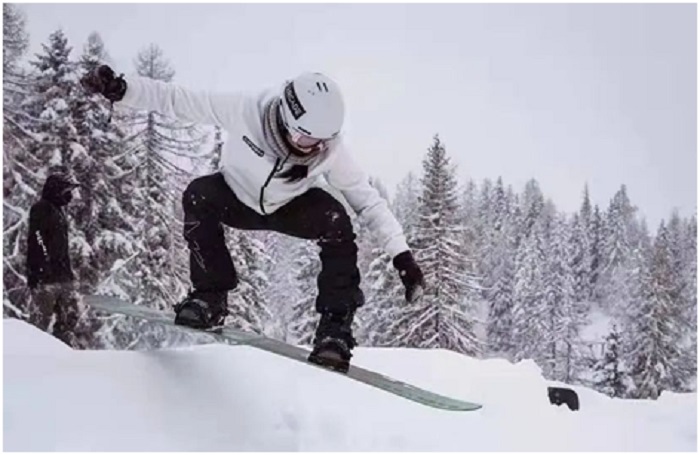



“I’m preparing for the next Winter Olympics. It’s my dream to win honor for our country at the Olympics,” said Yongqing Lhamo, a Chinese athlete born in Purong village, Wangda township, Zogang county, Qamdo city, southwest China’s Tibet autonomous region.
The 18-year-old snowboarder once created Chinese players’ best score at the FIS Women’s Snowboard Cross World Cup and qualified for the same event at the Beijing Winter Olympics, becoming the first-ever Tibetan athlete who has earned a Winter Olympic berth.
To boost the development of winter sports, Tibet selected talents for ice and snow sports from students at a local sports school and a mountaineering guide school in 2018. Yongqing Lhamo, who had been learning football, seized the opportunity.
It was in no way easy to switch from football to skiing, but Yongqing Lhamo managed it with an adventurous spirit and painstaking efforts.
Before she was admitted into Tibet’s skiing training team, Yongqing Lhamo had never heard about snowboard cross. “During the event, competitors need to race past high jumps, sharp turns and steep slopes, and whoever reaches the finish line first wins. It was amazing when I skied for the first time, and I immediately fell in love with the sport,” she said.
Since she practiced skiing, Yongqing Lhamo has participated in training and competitions in many places at home and abroad, and even competed in Winter Olympics.
“Athletes from the Qinghai-Tibet Plateau normally have good cardiopulmonary functions, remarkable endurance, and other advantages,” said Nyima Tsering, director of the Tibet Sports Bureau. Thanks to the selection mechanism of the General Administration of Sport of China that encourages athletes to take part in ice and snow sports regardless of their professional backgrounds, more and more athletes in Tibet have competed in winter sports competitions, according to him.
Tibet’s skiing team has competitive advantages in ski mountaineering and cross-country skiing, and has sent over 10 athletes to the national team, he said.
Rich in ice and snow resources including forests, mountains and glaciers, Tibet has become a world-class adventure and mountaineering destination.
Characteristic competitions held in Tibet, including the Trans-Himalaya International Extreme Cycling Race, the Tibet mountaineering conference and the Lhasa Half Marathon, not only intoxicate sports enthusiasts, but bring sports closer to local people.
As more residents of various ethnic groups in the region take pleasure in outdoor sports, mountaineering and skiing have increasingly become their first choices for enjoying ice and snow sports.
A number of characteristic towns featuring sports and leisure activities in Tibet, including Lulang township in Nyingchi city of the region, have witnessed robust development and driven local efforts to propel rural vitalization.
Statistics show that during China’s 13th Five-Year Plan period (2016-2020), Tibet received 2,337 mountaineering enthusiasts from home and abroad, achieving an output value of 77.64 million yuan ($12.2 million) and generating an income of 30.69 million yuan for local people.
As of the end of 2020, Tibet had nearly 8,300 sports facilities and the number of people who regularly participate in physical exercise reached 997,000, which accounted for nearly 30 percent of the total population of the region.
During the 13th Five-Year Plan period, Tibetan athletes claimed a total of 231 medals in international and domestic competitions, including two gold medals, three silver medals and four bronze medals won in international competitions.
At present, 336 teenage athletes from Tibet are receiving training in other province-level regions that have paired up with Tibet under the country’s “pairing assistance” program to provide assistance for Tibet with its development.
“These young athletes were born in a farmer’s or herdsman’s family, and yet their lives are totally different from those of their parents and ancestors,” said Nyima Tsering.
With the strong support of the country, Tibet’s competitive sports strength continues to improve while sports talents constantly emerge, he noted, adding that more and more young people in Tibet like Yongqing Lhamo have got the opportunity to receive training and compete in international competitions with top players from all over the world to win honor for their motherland.


The Executive and members of the.


The Acting Director, FCT Directorate of.


President Bola Ahmed Tinubu has been.



Barely a month after resignation of.


An Abuja based Legal Practitioner, Osuagwu.



Convener of Equitable Remedy, Mrs. Magaret.


Contractors handling the contract for city.


Nigerian government may have concluded plans.


The Diplomatic Correspondents Association of Nigeria.


A rights group, “Follow Me Talk.
Leave a Comment